Xubin Ren
DeepCode: Open Agentic Coding
Dec 08, 2025Abstract:Recent advances in large language models (LLMs) have given rise to powerful coding agents, making it possible for code assistants to evolve into code engineers. However, existing methods still face significant challenges in achieving high-fidelity document-to-codebase synthesis--such as scientific papers to code--primarily due to a fundamental conflict between information overload and the context bottlenecks of LLMs. In this work, we introduce DeepCode, a fully autonomous framework that fundamentally addresses this challenge through principled information-flow management. By treating repository synthesis as a channel optimization problem, DeepCode seamlessly orchestrates four information operations to maximize task-relevant signals under finite context budgets: source compression via blueprint distillation, structured indexing using stateful code memory, conditional knowledge injection via retrieval-augmented generation, and closed-loop error correction. Extensive evaluations on the PaperBench benchmark demonstrate that DeepCode achieves state-of-the-art performance, decisively outperforming leading commercial agents such as Cursor and Claude Code, and crucially, surpassing PhD-level human experts from top institutes on key reproduction metrics. By systematically transforming paper specifications into production-grade implementations comparable to human expert quality, this work establishes new foundations for autonomous scientific reproduction that can accelerate research evaluation and discovery.
RAG-Anything: All-in-One RAG Framework
Oct 14, 2025Abstract:Retrieval-Augmented Generation (RAG) has emerged as a fundamental paradigm for expanding Large Language Models beyond their static training limitations. However, a critical misalignment exists between current RAG capabilities and real-world information environments. Modern knowledge repositories are inherently multimodal, containing rich combinations of textual content, visual elements, structured tables, and mathematical expressions. Yet existing RAG frameworks are limited to textual content, creating fundamental gaps when processing multimodal documents. We present RAG-Anything, a unified framework that enables comprehensive knowledge retrieval across all modalities. Our approach reconceptualizes multimodal content as interconnected knowledge entities rather than isolated data types. The framework introduces dual-graph construction to capture both cross-modal relationships and textual semantics within a unified representation. We develop cross-modal hybrid retrieval that combines structural knowledge navigation with semantic matching. This enables effective reasoning over heterogeneous content where relevant evidence spans multiple modalities. RAG-Anything demonstrates superior performance on challenging multimodal benchmarks, achieving significant improvements over state-of-the-art methods. Performance gains become particularly pronounced on long documents where traditional approaches fail. Our framework establishes a new paradigm for multimodal knowledge access, eliminating the architectural fragmentation that constrains current systems. Our framework is open-sourced at: https://github.com/HKUDS/RAG-Anything.
RecGPT: A Foundation Model for Sequential Recommendation
Jun 06, 2025Abstract:This work addresses a fundamental barrier in recommender systems: the inability to generalize across domains without extensive retraining. Traditional ID-based approaches fail entirely in cold-start and cross-domain scenarios where new users or items lack sufficient interaction history. Inspired by foundation models' cross-domain success, we develop a foundation model for sequential recommendation that achieves genuine zero-shot generalization capabilities. Our approach fundamentally departs from existing ID-based methods by deriving item representations exclusively from textual features. This enables immediate embedding of any new item without model retraining. We introduce unified item tokenization with Finite Scalar Quantization that transforms heterogeneous textual descriptions into standardized discrete tokens. This eliminates domain barriers that plague existing systems. Additionally, the framework features hybrid bidirectional-causal attention that captures both intra-item token coherence and inter-item sequential dependencies. An efficient catalog-aware beam search decoder enables real-time token-to-item mapping. Unlike conventional approaches confined to their training domains, RecGPT naturally bridges diverse recommendation contexts through its domain-invariant tokenization mechanism. Comprehensive evaluations across six datasets and industrial scenarios demonstrate consistent performance advantages.
Urban Computing in the Era of Large Language Models
Apr 02, 2025Abstract:Urban computing has emerged as a multidisciplinary field that harnesses data-driven technologies to address challenges and improve urban living. Traditional approaches, while beneficial, often face challenges with generalization, scalability, and contextual understanding. The advent of Large Language Models (LLMs) offers transformative potential in this domain. This survey explores the intersection of LLMs and urban computing, emphasizing the impact of LLMs in processing and analyzing urban data, enhancing decision-making, and fostering citizen engagement. We provide a concise overview of the evolution and core technologies of LLMs. Additionally, we survey their applications across key urban domains, such as transportation, public safety, and environmental monitoring, summarizing essential tasks and prior works in various urban contexts, while highlighting LLMs' functional roles and implementation patterns. Building on this, we propose potential LLM-based solutions to address unresolved challenges. To facilitate in-depth research, we compile a list of available datasets and tools applicable to diverse urban scenarios. Finally, we discuss the limitations of current approaches and outline future directions for advancing LLMs in urban computing.
VideoRAG: Retrieval-Augmented Generation with Extreme Long-Context Videos
Feb 03, 2025



Abstract:Retrieval-Augmented Generation (RAG) has demonstrated remarkable success in enhancing Large Language Models (LLMs) through external knowledge integration, yet its application has primarily focused on textual content, leaving the rich domain of multi-modal video knowledge predominantly unexplored. This paper introduces VideoRAG, the first retrieval-augmented generation framework specifically designed for processing and understanding extremely long-context videos. Our core innovation lies in its dual-channel architecture that seamlessly integrates (i) graph-based textual knowledge grounding for capturing cross-video semantic relationships, and (ii) multi-modal context encoding for efficiently preserving visual features. This novel design empowers VideoRAG to process unlimited-length videos by constructing precise knowledge graphs that span multiple videos while maintaining semantic dependencies through specialized multi-modal retrieval paradigms. Through comprehensive empirical evaluation on our proposed LongerVideos benchmark-comprising over 160 videos totaling 134+ hours across lecture, documentary, and entertainment categories-VideoRAG demonstrates substantial performance compared to existing RAG alternatives and long video understanding methods. The source code of VideoRAG implementation and the benchmark dataset are openly available at: https://github.com/HKUDS/VideoRAG.
MiniRAG: Towards Extremely Simple Retrieval-Augmented Generation
Jan 14, 2025



Abstract:The growing demand for efficient and lightweight Retrieval-Augmented Generation (RAG) systems has highlighted significant challenges when deploying Small Language Models (SLMs) in existing RAG frameworks. Current approaches face severe performance degradation due to SLMs' limited semantic understanding and text processing capabilities, creating barriers for widespread adoption in resource-constrained scenarios. To address these fundamental limitations, we present MiniRAG, a novel RAG system designed for extreme simplicity and efficiency. MiniRAG introduces two key technical innovations: (1) a semantic-aware heterogeneous graph indexing mechanism that combines text chunks and named entities in a unified structure, reducing reliance on complex semantic understanding, and (2) a lightweight topology-enhanced retrieval approach that leverages graph structures for efficient knowledge discovery without requiring advanced language capabilities. Our extensive experiments demonstrate that MiniRAG achieves comparable performance to LLM-based methods even when using SLMs while requiring only 25\% of the storage space. Additionally, we contribute a comprehensive benchmark dataset for evaluating lightweight RAG systems under realistic on-device scenarios with complex queries. We fully open-source our implementation and datasets at: https://github.com/HKUDS/MiniRAG.
EasyRec: Simple yet Effective Language Models for Recommendation
Aug 16, 2024



Abstract:Deep neural networks have become a powerful technique for learning representations from user-item interaction data in collaborative filtering (CF) for recommender systems. However, many existing methods heavily rely on unique user and item IDs, which limits their ability to perform well in practical zero-shot learning scenarios where sufficient training data may be unavailable. Inspired by the success of language models (LMs) and their strong generalization capabilities, a crucial question arises: How can we harness the potential of language models to empower recommender systems and elevate its generalization capabilities to new heights? In this study, we propose EasyRec - an effective and easy-to-use approach that seamlessly integrates text-based semantic understanding with collaborative signals. EasyRec employs a text-behavior alignment framework, which combines contrastive learning with collaborative language model tuning, to ensure a strong alignment between the text-enhanced semantic space and the collaborative behavior information. Extensive empirical evaluations across diverse real-world datasets demonstrate the superior performance of EasyRec compared to state-of-the-art alternative models, particularly in the challenging text-based zero-shot recommendation scenarios. Furthermore, the study highlights the potential of seamlessly integrating EasyRec as a plug-and-play component into text-enhanced collaborative filtering frameworks, thereby empowering existing recommender systems to elevate their recommendation performance and adapt to the evolving user preferences in dynamic environments. For better result reproducibility of our EasyRec framework, the model implementation details, source code, and datasets are available at the link: https://github.com/HKUDS/EasyRec.
XRec: Large Language Models for Explainable Recommendation
Jun 04, 2024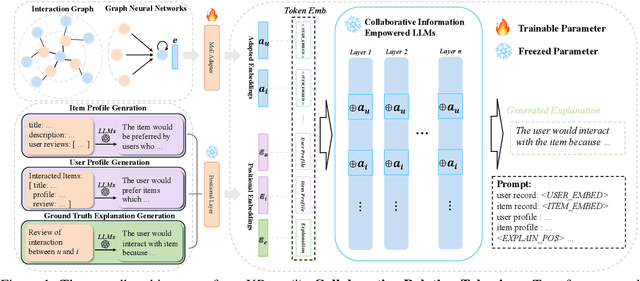
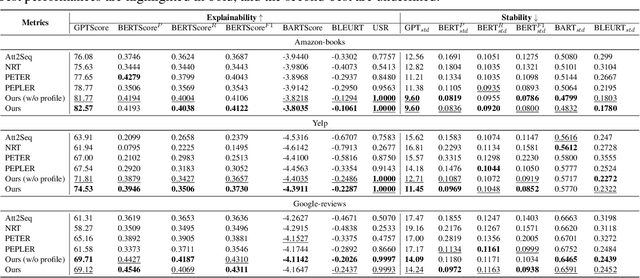


Abstract:Recommender systems help users navigate information overload by providing personalized recommendations aligned with their preferences. Collaborative Filtering (CF) is a widely adopted approach, but while advanced techniques like graph neural networks (GNNs) and self-supervised learning (SSL) have enhanced CF models for better user representations, they often lack the ability to provide explanations for the recommended items. Explainable recommendations aim to address this gap by offering transparency and insights into the recommendation decision-making process, enhancing users' understanding. This work leverages the language capabilities of Large Language Models (LLMs) to push the boundaries of explainable recommender systems. We introduce a model-agnostic framework called XRec, which enables LLMs to provide comprehensive explanations for user behaviors in recommender systems. By integrating collaborative signals and designing a lightweight collaborative adaptor, the framework empowers LLMs to understand complex patterns in user-item interactions and gain a deeper understanding of user preferences. Our extensive experiments demonstrate the effectiveness of XRec, showcasing its ability to generate comprehensive and meaningful explanations that outperform baseline approaches in explainable recommender systems. We open-source our model implementation at https://github.com/HKUDS/XRec.
A Comprehensive Survey on Self-Supervised Learning for Recommendation
Apr 07, 2024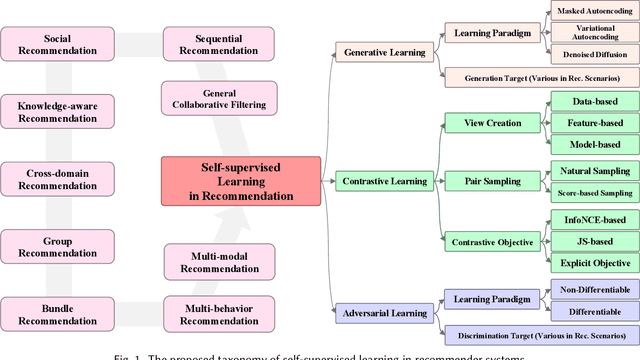
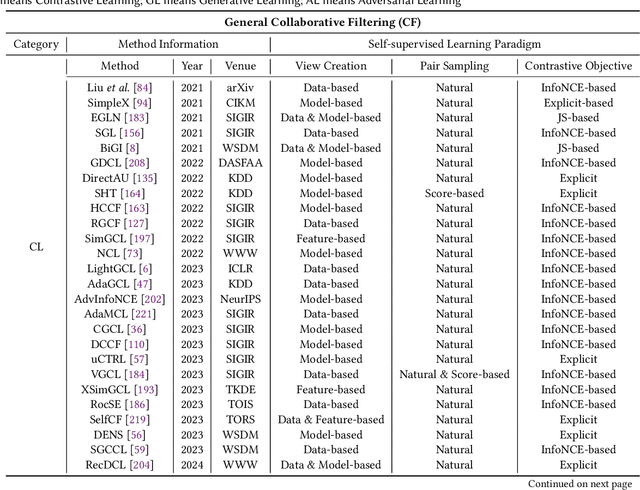

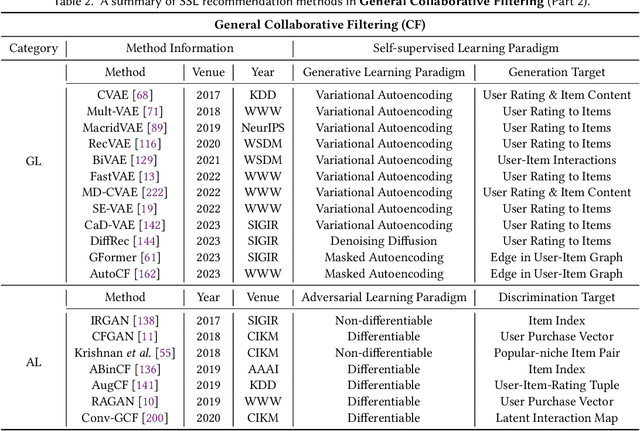
Abstract:Recommender systems play a crucial role in tackling the challenge of information overload by delivering personalized recommendations based on individual user preferences. Deep learning techniques, such as RNNs, GNNs, and Transformer architectures, have significantly propelled the advancement of recommender systems by enhancing their comprehension of user behaviors and preferences. However, supervised learning methods encounter challenges in real-life scenarios due to data sparsity, resulting in limitations in their ability to learn representations effectively. To address this, self-supervised learning (SSL) techniques have emerged as a solution, leveraging inherent data structures to generate supervision signals without relying solely on labeled data. By leveraging unlabeled data and extracting meaningful representations, recommender systems utilizing SSL can make accurate predictions and recommendations even when confronted with data sparsity. In this paper, we provide a comprehensive review of self-supervised learning frameworks designed for recommender systems, encompassing a thorough analysis of over 170 papers. We conduct an exploration of nine distinct scenarios, enabling a comprehensive understanding of SSL-enhanced recommenders in different contexts. For each domain, we elaborate on different self-supervised learning paradigms, namely contrastive learning, generative learning, and adversarial learning, so as to present technical details of how SSL enhances recommender systems in various contexts. We consistently maintain the related open-source materials at https://github.com/HKUDS/Awesome-SSLRec-Papers.
LLMRec: Large Language Models with Graph Augmentation for Recommendation
Nov 17, 2023Abstract:The problem of data sparsity has long been a challenge in recommendation systems, and previous studies have attempted to address this issue by incorporating side information. However, this approach often introduces side effects such as noise, availability issues, and low data quality, which in turn hinder the accurate modeling of user preferences and adversely impact recommendation performance. In light of the recent advancements in large language models (LLMs), which possess extensive knowledge bases and strong reasoning capabilities, we propose a novel framework called LLMRec that enhances recommender systems by employing three simple yet effective LLM-based graph augmentation strategies. Our approach leverages the rich content available within online platforms (e.g., Netflix, MovieLens) to augment the interaction graph in three ways: (i) reinforcing user-item interaction egde, (ii) enhancing the understanding of item node attributes, and (iii) conducting user node profiling, intuitively from the natural language perspective. By employing these strategies, we address the challenges posed by sparse implicit feedback and low-quality side information in recommenders. Besides, to ensure the quality of the augmentation, we develop a denoised data robustification mechanism that includes techniques of noisy implicit feedback pruning and MAE-based feature enhancement that help refine the augmented data and improve its reliability. Furthermore, we provide theoretical analysis to support the effectiveness of LLMRec and clarify the benefits of our method in facilitating model optimization. Experimental results on benchmark datasets demonstrate the superiority of our LLM-based augmentation approach over state-of-the-art techniques. To ensure reproducibility, we have made our code and augmented data publicly available at: https://github.com/HKUDS/LLMRec.git
 Add to Chrome
Add to Chrome Add to Firefox
Add to Firefox Add to Edge
Add to Edge